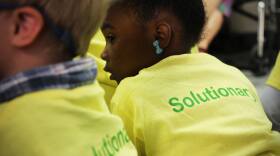Bentley loves people. He’s usually wearing a big smile. He’s a joy. But his mother, Adrienne Crawford, admits he’s a lot of work, too.
“I took a three-minute shower" the other day, says Crawford. "And I came back and his bedroom was covered in baby powder. I don’t know why he did it. I guess it looks fun, just pouring white powder on the floor.”
Bentley has Down syndrome.
Shortly after he was born, Crawford remembers reading a book that forecast everything that could possibly go wrong in her young son’s life.
“He’ll probably need tubes," she remembers reading. "Heart defects. Gastrointestinal problems, and that he’s more likely to get leukemia. Severe cognitive delays. He probably will never live on his own. He won’t ever be able to drive a car. It was like, all these things that he won’t do in life.”
Bentley’s five years old now. His heart is healthy, and now he’s got two younger siblings, Clayton and Lily.
Off to school
Bentley is a kindergartner at the James and Grace Lee Boggs School, two miles east of the Crawfords’ house.
She investigated Detroit Public Schools and a few other charter schools.
“We wanted a school that wanted him," Crawford says. "I went to at least four schools in Detroit, and none of them seemed to want Bentley in their classroom or in their school.”
Crawford says at some of the schools, there seemed to be a lot of red tape involved.
“'Well, you need to go downtown to fill out this paperwork,'" Crawford recalls. "And then I’d go downtown. 'Oh, this is too early to fill out this paper work.' And then one school, the special-needs kids are in the basement."
Crawford says nothing felt like the right fit. Until last summer, when the Crawfords met some people who were starting up a brand-new school. They were from the Boggs School.
“They were handing out flyers for this school and I read about the things that they want to do with place-based education, and I thought, 'that seems really neat. But I don’t know if they will want Bentley,'" she recalls. "But they said,'absolutely, we would love your son. He would bless our school.' And I was like, nobody says that. Who are these people?”
The Right Fit
There's no special education class. Instead, students with special needs spend most of their day with everyone else.
The Boggs School practices what’s known as inclusive education, where students with disabilities aren’t separated. There is no special-education class. Instead, students with special needs spend most of their day with everyone else.
Bentley works outside the classroom with a speech and occupational therapist, as well as a special-education teacher. However, for the most part, Bentley is in class, with all the other kids his age. There is a teacher's assistant in the classroom, mainly to help Bentley.
Kindergarten teacher Christina Smith recalls talking to Adrienne Crawford before the school year began, asking her how she wanted Bentley's disability to be discussed in the classroom.
“And she said, 'I want you to tell them that he has Down syndrome,'" says Smith. "He has Down syndrome like some people have curly hair. It is a part of who he is."
Bentley from andrea claire maio on Vimeo.
Principal Julia Putnam can’t say enough about how beneficial inclusion has been in the kindergarten class. Not just for Bentley, but for all the students.
“It’s important to have different people around you," says Putnam, adding that students with disabilities get as much out of the experience as the other children in the classroom.
“There’s one boy in Bentley’s class who has taken it upon himself to be Bentley’s keeper," says Putnam. "And this particular boy was getting a talking-to on the playground, and he said to the adult, 'Hold on a second,' mid-lecture, and he turned and he took a wood chip that Bentley was about to put in his mouth, and he took it away and turned back to the lecture and said, 'Ok. You can finish.'”
According to the U.S. Department of Education, more than half of kids with intellectual and developmental disabilities spend their entire day segregated in special-education classrooms. However, research indicates inclusion is beneficial for all students, not just the ones with disabilities.
“The kids are learning that you take care of one another and they’re learning how to do that in a respectful way. And that’s a powerful thing," says Putnam. "And I’m not sure that they would be learning it as well if Bentley weren’t there.”
Sometimes Bentley runs out of the classroom in the middle of the day. Sometimes he’ll play with building blocks while the rest of the class is joined in a circle. But the goal of inclusion isn’t for Bentley to be like all the other kids. The goal of inclusion is for Bentley to be with all the other kids. He learns from them. They learn from him. Everyone grows. That’s the idea.
This report from Zak Rosen is part 5 of our continuing series on the James and Grace Lee Boggs School. Catch up on the series.









